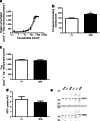ANT1-mediated fatty acid-induced uncoupling as a target for improving myocellular insulin sensitivity
- PMID: 26886198
- PMCID: PMC4826430
- DOI: 10.1007/s00125-016-3885-8
ANT1-mediated fatty acid-induced uncoupling as a target for improving myocellular insulin sensitivity
Abstract
Aims/hypothesis: Dissipating energy via mitochondrial uncoupling has been suggested to contribute to enhanced insulin sensitivity. We hypothesised that skeletal muscle mitochondria of endurance-trained athletes have increased sensitivity for fatty acid (FA)-induced uncoupling, which is driven by the mitochondrial protein adenine nucleotide translocase 1 (ANT1).
Methods: Capacity for FA-induced uncoupling was measured in endurance-trained male athletes (T) and sedentary young men (UT) in an observational study and also in isolated skeletal muscle mitochondria from Zucker diabetic fatty (ZDF) rats and C2C12 myotubes following small interfering RNA (siRNA)-mediated gene silencing of ANT1. Thus, fuelled by glutamate/succinate (fibres) or pyruvate (mitochondria and myotubes) and in the presence of oligomycin to block ATP synthesis, increasing levels of oleate (fibres) or palmitate (mitochondria and myotubes) were automatically titrated while respiration was monitored. Insulin sensitivity was measured by hyperinsulinaemic-euglycaemic clamp in humans and via insulin-stimulated glucose uptake in myotubes.
Results: Skeletal muscle from the T group displayed increased sensitivity to FA-induced uncoupling (p = 0.011) compared with muscle from the UT group, and this was associated with elevated insulin sensitivity (p = 0.034). ANT1 expression was increased in T (p = 0.013). Mitochondria from ZDF rats displayed decreased sensitivity for FA-induced uncoupling (p = 0.008). This difference disappeared in the presence of the adenine nucleotide translocator inhibitor carboxyatractyloside. Partial knockdown of ANT1 in C2C12 myotubes decreased sensitivity to the FA-induced uncoupling (p = 0.008) and insulin-stimulated glucose uptake (p = 0.025) compared with controls.
Conclusions/interpretation: Increased sensitivity to FA-induced uncoupling is associated with enhanced insulin sensitivity and is affected by ANT1 activity in skeletal muscle. FA-induced mitochondrial uncoupling may help to preserve insulin sensitivity in the face of a high supply of FAs.
Trial registration: www.trialregister.nl NTR2002.
Keywords: ANT1; Fatty acid-induced uncoupling; Skeletal muscle insulin sensitivity.
Figures




References
-
- Meex RC, Schrauwen-Hinderling VB, Moonen-Kornips E, et al. Restoration of muscle mitochondrial function and metabolic flexibility in type 2 diabetes by exercise training is paralleled by increased myocellular fat storage and improved insulin sensitivity. Diabetes. 2010;59:572–579. doi: 10.2337/db09-1322. - DOI - PMC - PubMed
-
- Phielix E, Meex R, Moonen-Kornips E, Hesselink MK, Schrauwen P. Exercise training increases mitochondrial content and ex vivo mitochondrial function similarly in patients with type 2 diabetes and in control individuals. Diabetologia. 2010;53:1714–1721. doi: 10.1007/s00125-010-1764-2. - DOI - PMC - PubMed
Publication types
MeSH terms
Substances
LinkOut - more resources
Full Text Sources
Other Literature Sources
Research Materials
Miscellaneous

